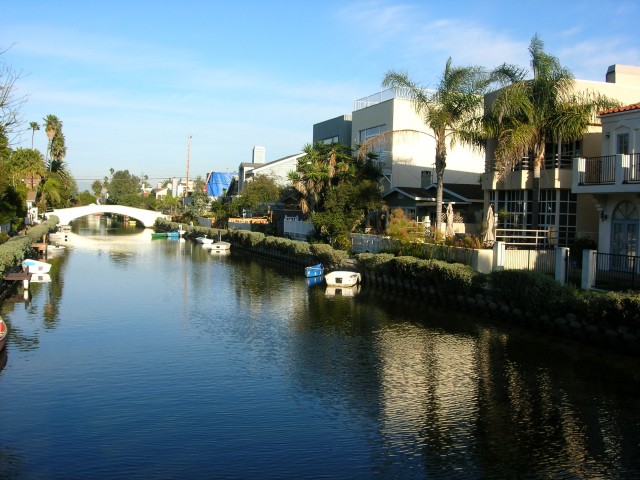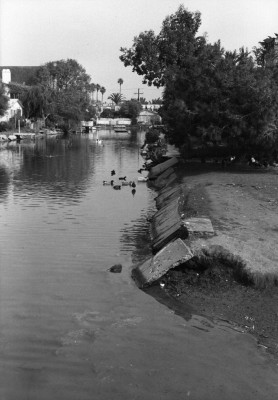
When I lived in Venice Beach, I regularly walked visitors through the picturesque canals. We meandered up and down the maze of sidewalks, where evenly manicured shrubs separate the footpaths from six sparkling waterways. Arched wooden footbridges allowed us to cross over each of the channels and catch a better view of the remodeled and colorfully painted California bungalows, bright and open three-story homes, and a few much larger gingerbread-looking houses with undulating rooftops. The songs of various birds could be heard everywhere, and a slow-moving current slapped the concrete walls. All this, with the faint salt and algae smell, could lull anyone into a romantic trance.
The canals aren’t merely waterways. Venice itself is a community that reflects a new age of urban diversity, where upscale boutiques and million-dollar homes are just a short walk away from housing projects, homeless encampments, and the world-famous boardwalk, L.A.’s most dynamic public mixing ground of different races and classes. Yet the canals feel exclusive amidst this backdrop; you are free to walk through and take in the sights–indeed you could stare at the portrait they create for hours–but it is unlikely you can afford to live there.
It wasn’t always this way. The canals were once Venice’s most unconventional section, which is telling, since Venice has long been considered L.A’s center of nonconformity, a Mecca for alternative and countercultural lifestyles, where just about anybody could fit in.
In 1942, the city closed off the canal sidewalks to the public because they had collapsed into the waterways. The sidewalks remained that way for the next five decades. People who knew the neighborhood referred to it as a “swamp.” The water was at times so stagnant, shallow, and filled with algae that it appeared less like a series of man-made waterways and more like a slimy, mud-filled marsh. On a breezy day, the corroded and fishy smells wafted up the coast.
During the 1950s and ’60s, the development of Los Angeles was in flux. New suburban growth came to Culver City, and major plans were put in place to transform barren marshes spotted with abandoned oil derricks just south of the canals into an upper-middle-class leisure district called Marina del Rey. Planning studies found that Venice’s canals and housing infrastructure were in a state of disrepair and its beaches were polluted. They labeled the coastal community a “slum.” Many people who could afford to move out of Venice did.
But some people disliked the growing middle-class suburbanization of L.A. and discovered in Venice great treasures: affordable housing, a live-and-let-live atmosphere, and proximity to the Pacific Ocean. The bohemians settling into the canals adopted a self-imposed poverty. Most grew up in working-and middle-class families, but they were looking to escape to something more meaningful. First, the poets of the beat movement arrived, along with Korean War veterans. Hippies more concerned with the Vietnam War and the civil rights movement followed, as did many artists and musicians. The canals came to represent everything that the new suburbs were not: no one worked 9 to 5 jobs; people shared their homes, avoiding the trend of single-family dwellings; women exploded traditional gender constraints by becoming political activists, artists, craftswomen, and musicians; and residents welcomed temporary travelers who slept on numerous empty lots.
Those empty lots are unimaginable today. Not a single vacant lot remains on the canals, except for the few protected by residents with enough money to purchase additional properties and keep them empty for a vibrant garden or splendid side yard. In the 1960s, however, one-third of the canal lots were abandoned and much of the space was overgrown. The “hippie canals,” as the neighborhood was called, had an air of transience, and a distinctly pungent marijuana smell. People drove in and camped out in the lots as if they were visiting a state park. Hippies, dogs, and ducks paraded through, coexisting with bikers, musicians, draft resisters, and the unemployed. People sold just about anything to get by: vegetables from their gardens, antiques and crafts out of their garages, and hallucinogens of all sorts.
While the ’60s counterculture started as an unfocused opposition to middle-class norms, protest organizations soon formed, mostly in response to the local property speculation–putting the canals at the heart of new political conflicts. Developers initiated new attempts to reinvent the canals by linking them to the planned Marina del Rey. They wanted to deepen and widen the waterways so new residents could dock their larger boats and easily navigate them into the marina and out to the Pacific Ocean. The Peace and Freedom Party had been organizing a “Free Venice” movement to give the neighborhood local control–and to fight against enforcement programs that affected the housing of poorer residents, to stop police assaults on hippies and minorities, and to oppose developments to attract wealthier residents into Venice.
Canal residents–mostly renters–succeeded in stopping attempts to link the canals to Marina del Rey, but they did not completely halt neighborhood change. As the marina project was finalized in 1965, speculators continued to push for revitalization of the canals. They wanted to redesign the entire canal infrastructure and make it pedestrian friendly, construct new housing, fix the footbridges, and boost property values. But it was not until a new middle class crept into town in the mid-1970s that the canals really started to change.
The earliest middle-class homeowners were attracted to the abundant and cheap housing near the beach. All of Venice was affordable in those days, but the canals were the most economical. Some fixed up crumbling bungalows, and others found the newer duplex designs appealing for the possibility of extra income from a second unit. When individuals with noticeably different habits, material possessions, aesthetic sensibilities, and political interests moved in, the everyday culture of the place took on familiar hints of suburbia. People mowed their lawns and painted their houses; they put up fences and drove more expensive cars; and they worked longer hours at their more conventional professions. The middle-class culture became visible, and the media, and more prospective home-buyers, noticed.
The new middle class admired the unconventional culture, but they did not participate in it. While they did not organize to push out the countercultural and economically diverse renters, they took part in local politics in response to developers’ aggressive strategies.
The countercultural renters tried to hold onto their free-spirited ways, throwing massive parties and festivals and opposing all development whatsoever. But for the first time, homeowners made up the majority of the neighborhood’s residents. They advocated for sensible development that fit the environment: nothing too big, too bulky, or out of character, and especially no connections to Marina del Rey, for they feared the sight of yachts docked out front. The compromise between homeowners and developers meant that almost all property owners would support some sort of rehabilitation. After decades of struggles, the neighborhood was finally refurbished, and fitted with new sidewalks, new canal walls, restored footbridges, and technologies to flush out stagnant water.
The revitalization made the place more enticing to an even wealthier class. Neighborhood changes always involve unintended consequences. Middle-class homeowners are now considered the “old-timers” of the canals, and they wax nostalgic about their early years when the houses were smaller, wild and overgrown plants covered the jagged sidewalks, and property values were a small fraction of current rates. When I walk around today, multiple eras of the past are invisible. The canals are far from being a middle-class neighborhood and even further from being a bohemia. Cities are always changing. No one can pause history or direct the future to some exact end.
Buy the Book: Skylight Books, Amazon, Powell’s.
Andrew Deener is an assistant professor of sociology at the University of Connecticut and author of Venice: A Contested Bohemia in Los Angeles (University of Chicago Press, 2012).
*Top photo by Andrew Deener. Interior photo by Darryl DuFay.





Send A Letter To the Editors